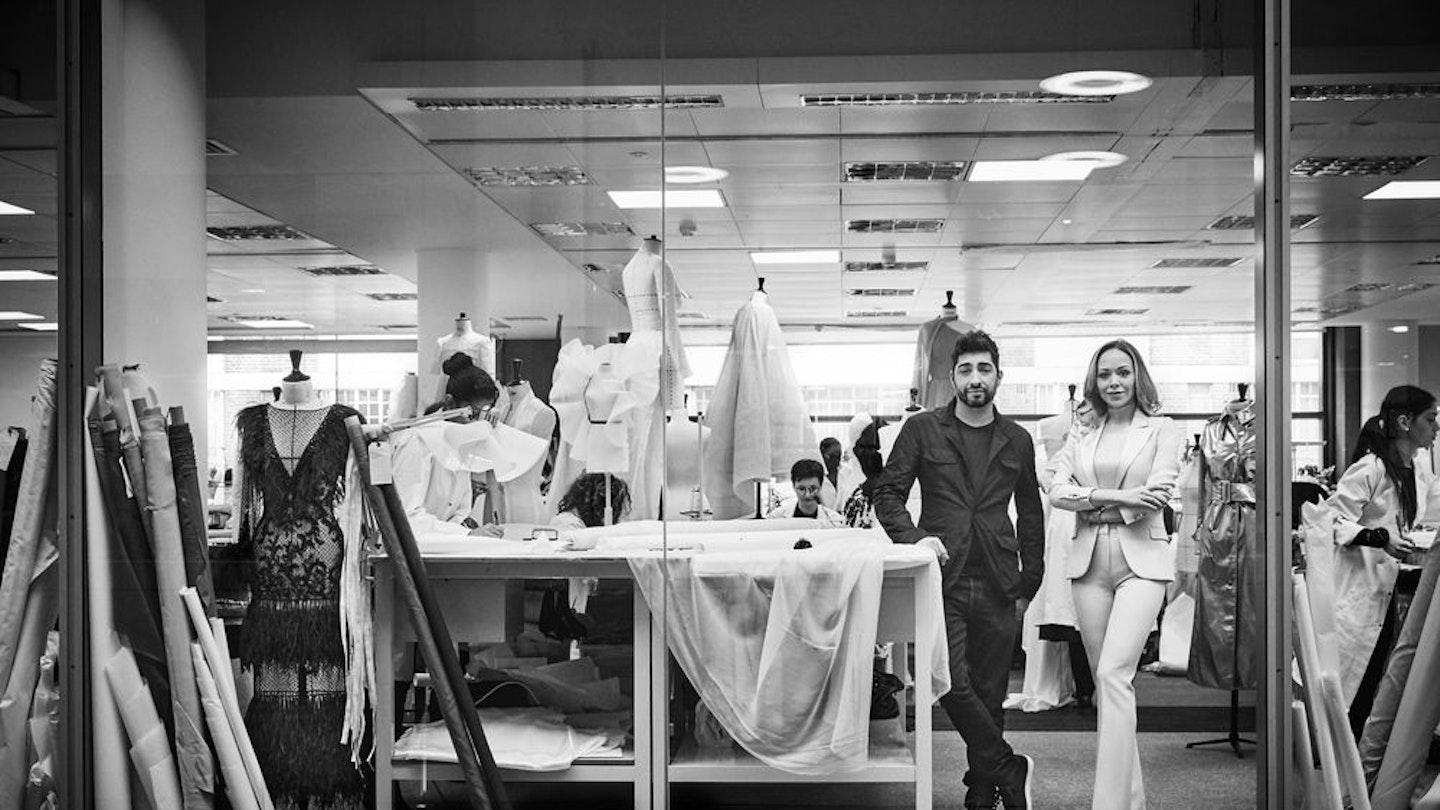I must confess, the only reason I arranged an interview with Ralph & Russo for our Luxury issue – aside from the fact that I’m fascinated by the world’s fastest growing luxury brand – was to find out one thing: were they, or were they not, doing the dress?
By the time you read this, Meghan Markle’s Givenchy wedding gown by Clare Waight Keller has been appraised by approximately 1.4 billion TV viewers worldwide, with around the same amount of column inches dedicated to its every detail.
However, when I meet the Australian- born, London-based duo, Tamara Ralph (creative director) and Michael Russo (her life and business partner) in April – three weeks before the wedding – the pair are odds-on favourites, with Erdem, Stella McCartney and Christopher Bailey also in the running. The week before the wedding, bookies even closed the bets, so sure were they that Ralph & Russo had made the dress.
We are sitting at a table in a pristine office inside their industrious atelier, an impressive 25,000 square foot space on Sloane Avenue, in the heart of South Kensington, one of London’s wealthiest postcodes. It’s Ralph & Russo’s eighth office move, thanks to the company doubling in size every year they’ve been in business – and they’re already at capacity in this new location. The scene is a breathtaking hive of activity, with hundreds of young women bent over their work, six of them stitching miniscule silk flowers to what appears to be a five-metre-long bridal veil.
Little do I know at the time that Michael and Tamara are being stalked by the press; long lenses probably trained into their windows from buildings across the street as we speak. Or that they are receiving 800 email enquiries a day from around the world, and that their website keeps crashing. Days earlier, a photograph of Prince Harry coming out of their office entrance has only added fuel to the speculation, now at fever pitch, prompting the Daily Mail to boom: ‘Meghan Will Wear £100,000 design made by British Couturiers, Ralph & Russo.’
So, is it true, I ask?
‘Have a biscuit!’ says Michael Russo, anxiously. Extracting any information regarding the royal nuptials is the equivalent of getting blood out of the proverbial stone. They have been gagged with a royal NDA (non-disclosure agreement) since December last year, when Meghan picked out that beautiful black gown (said to have cost £56,000) to wear for her official engagement pictures – at this point, they can’t say anything, yes or no. There is even a poster on the wall of their studio telling all employees NOT to speak to the press under any circumstances, and that all questions should be directed through their PR, Georgia Castleman. (I later discover that Michael, Tamara and Georgia were the only people who knew of the making of the engagement dress – everyone else in the company found out along with the rest of us in December.)
‘So what did Meghan’s choice of engagement gown tell you about the type of woman she is?’ I ask Tamara, who eventually relents: ‘I think she’s an incredibly inspirational woman and I love the fact she took a different turn and wore something that people did not expect. It was a beautiful piece but it wasn’t expected for an engagement photo – to go for that colour [black], that type of dress [a risqué mesh top with strategically placed embroidered golden leaves and long lush skirt], I think that really gave her the spirit of an independent woman.’
Tamara is a total revelation. Our photographer describes her in a one word email after our photo session: ‘HOT!’ Not only does she not look like any designer I’ve ever encountered, she is a direct, plain-speaking, dry-humoured Aussie who exudes total calm. Not for her jeans, trainers and the harried expression of someone being hunted by the media. She wears a cream silk cashmere sweater exposing a naked shoulder and svelte gym-toned arm; a ginormous gold Rolex ashes on her wrist, a gobstopper pearl of a ring on her finger, pebble-sized diamonds in her ears. Below the waist: a short pale tweed skirt and knee-high, laced-front, vertiginous snakeskin boots – all her own designs. Long, bouncy A-lister hair and red-carpet-ready make-up. It is 11am.
Her appearance is not for my benefit: she always dresses like this. Like a chauffeur-driven couture client. And that’s the point: every fibre of her being embodies the Ralph & Russo brand. As she puts it: ‘There’s no product I wouldn’t wear myself – if there’s something I see that I wouldn’t wear, it won’t get made.
And as Michael will later tell me: ‘When people say, “Who is the Ralph & Russo woman?” I point at her. It’s all her. Everything about Tamara, her work ethic, the way she holds herself, the way she dresses to the way she lives her life – that is who the brand is.’
Tamara: ‘Thank you, darling!’
Michael: ‘You’re really welcome... Well, it is your job!’
Their story is the stuff of fairy tales. Tamara met Michael in 2004, the first day she arrived in London on holiday. Serendipitously, she collided into him on a street in Fulham. Her, aged 22, a middle- class girl from Sydney with a head full of dreams of becoming a couturier. Him, 24, a ‘humble’ boy from Brisbane who had just quit his investment banking job. ‘Michael complimented me on my coat, a trench coat I’d made. And I thought, well, he’s got style,’ laughs Tamara. They fell in love and began a long-distance relationship. A year later, Michael phoned her to say he’d bought her a one-way ticket from Sydney to London: ‘“You leave next week,” he said. And I didn’t hesitate. When I arrived, I said, “OK, I’m here now, what am I going to do?” And he said, “I’ve thought about that. And I’ve bought you a sewing machine...”’
Tamara had grown up with fashion. Her grandmother, who had worked in haute couture in London and design studios in Sydney, encouraged her from when she was knee-high. ‘If I stitched something, she would say, “This is not right, unpick this, do it again,” – she was really great, really ruthless,’ recalls Tamara, who was 12 when she sold her first piece and 14 when she started working in boutiques, wearing her own designs, which led to making clothes for friends and private clients.
The couple first lived in Richmond together. ‘I had a little office, literally a cupboard – in fact some of the cupboards here are bigger than my first office; if you opened the door you smashed into the sewing machine. Michael had to sit on the edge of the table,’ says Tamara. Although they registered the company name in 2007, they spent three valuable years researching the industry and strategising the business before selling their first designs under Ralph & Russo – unheard of in this day and age where designers jump straight into the business the minute they’ve graduated. Says Michael, ‘We were literally two people walking into a client’s home with a sketch, some fabric swatches and asking for tens of thousands of pounds, saying, “This is Ralph & Russo – we’ve been around six months!”’
Remarkably, two of their first celebrity clients were Beyoncé and Angelina Jolie. ‘We were doing some bespoke work with members of the royal family,’ says Tamara. ‘They were introduced to the brand through a royal family member – but I prefer not to say who.’ That R&R was so under the radar at that point, a word-of- mouth brand, made them all the more sought-after by those in the limelight.
‘It made us more exclusive. We worked so closely with them, and it was all very private – which they seemed to love.’ It also set them up neatly as the brand with ‘a personal touch’, a million miles away from their instantly recognisable competitors Chanel and Dior. ‘The way we treat people is very personal and it’s how we started, that’s why we have a business – it’s truly part of the DNA, it’s how we are,’ says Michael.
But the privacy factor exploded in January 2014, when they became the first British couture house in a century to be invited by the Chambre Syndicale (French fashion’s governing body) to show at Paris Couture Week. ‘It definitely put us on the map. Not only from a recognition perspective, but also our credibility,’ says Michael. Mind you, some clients were a little miffed at their sudden exposure, remembers Tamara. ‘Clients phoned up to say, “We heard you’re showing at Paris Fashion Week? But then everyone’s going to know! You’re not going to be my secret anymore.” We even had clients crying at the show.’
Their rise in the fashion firmament has been nothing short of phenomenal. Today, they can lay claim to thousands of couture clients, babies to grandmothers, from Beijing to Brazil. The company is said to be growing by 400 per cent every year and was given an undisclosed nine-figure valuation when the British Phones 4 U billionaire John Caudwell bought a seven per cent stake in their business last year. Having already diversified with ready-to-wear, now fragrance, make-up and sunglasses are all in the pipeline. They employ 400 people. They have three stores: two in London, one in Paris, with six more slated to open this year in Dubai, Monaco, Doha, New York, Miami and Hong Kong. Plus a social media reach of five million. The magnitude of the business – to have grown so far and so fast in just eight years – is fairly mind-boggling, if not unheard of in the luxury fashion world.
‘We have made ourselves more accessible,’ says Michael, simply. ‘The reason other houses haven’t experienced the volume we have is that there’s so many emerging markets, and many customers have heard of couture, but how many have actually seen it, touched it, experienced it?’ In every store, Michael ensures there is a selection of couture pieces to try on and be fitted in there and then, meaning clients don’t have to go the traditional route – to an intimidating house in Paris. ‘Our catchphrase is “there’s no room for arrogant luxury” – we’re the opposite. We are the same people, always, whether we’re talking to the lady who lives down the street or to the royal family – we’re two down-to-earth Australians who love what we do.’
Post wedding, I contact R&R for some follow-up quotes. I wonder what it must have been like being caught up in a world media frenzy? How not being able to say they hadn’t done the dress may have appeared to fan the flames and in doing so called the company’s integrity into question? ‘Like any of these situations, it’s difficult when you can’t control the message. Our relationship with Kensington Palace and our signed NDA meant we could not comment at all.’ Privacy is their byword. ‘The business was built on discretion, we would never discuss our private clients or the price points of any custom pieces – we never have and we never will – discretion and trust is key.’ But the furore? The personal stalking? All Michael will say is that it was so full-on, ‘I actually nearly started to question it myself.’ And what of the effect of it all on their business? ‘It would be crazy to say that the level of attention and speculation hasn’t had any impact. But with this comes a level of responsibility to protect that person’s trust. All we can hope is that we continuously prove to be just that: a trusted partner with whom our clients feel secure in not only the design, but the brand.’ As for the actual Givenchy wedding dress, Tamara graciously adds: ‘Claire created a truly exceptional look, simple, timeless, elegant.’
When I left them on the day of our interview, I asked Tamara what she wore to her own wedding, thinking it might shed some light on what she’d design for the dress of the year. It turns out they’ve been far too busy to get married. So, what will she wear when they finally get round to it? ‘I’d probably do a white tuxedo or a jumpsuit and a big hat,’ says Tamara. ‘One thing’s for sure,’ chimes in Michael, ‘it’s going to be the hardest wedding dress she’ll ever make; she’ll be her most difficult client!’
Look back at royal wedding dresses through history in the gallery below...
Royal wedding dresses through history - Grazia
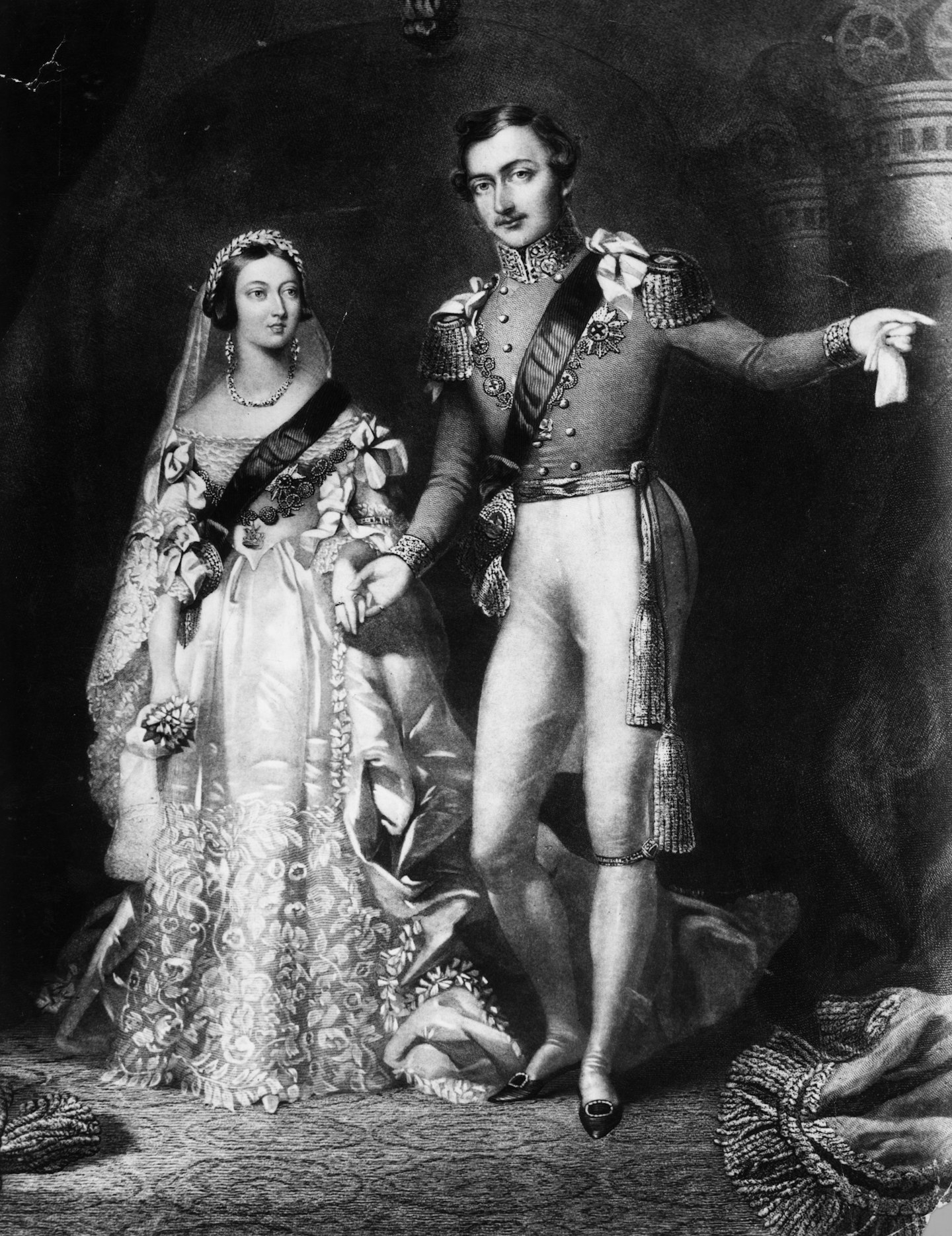 1 of 18
1 of 18Queen Victoria, 1840
Queen Victoria is one of just two British Queens to have married while reigning (the other is Queen Mary). For her wedding to Prince Albert at St James' Palace, the young Queen chose a simple off-the-shoulder style in white satin, with a flounce of Honiton lace at the neckline. Instead of a coronet, she wore a simple orange blossom garland.
 2 of 18
2 of 18Victoria, Princess Royal, 1858
Princess Victoria, daughter of Queen Victoria, wed Prince Frederick William of Prussia, in January 1858 wearing a rich white moire antique decorated with three flounces of Honiton lace designed to resemble bouquets of rose, shamrock and thistle in three medallions. Each flounce of the dress had a wreath of orange and myrtle blossoms, which were the bridal flower of Germany.
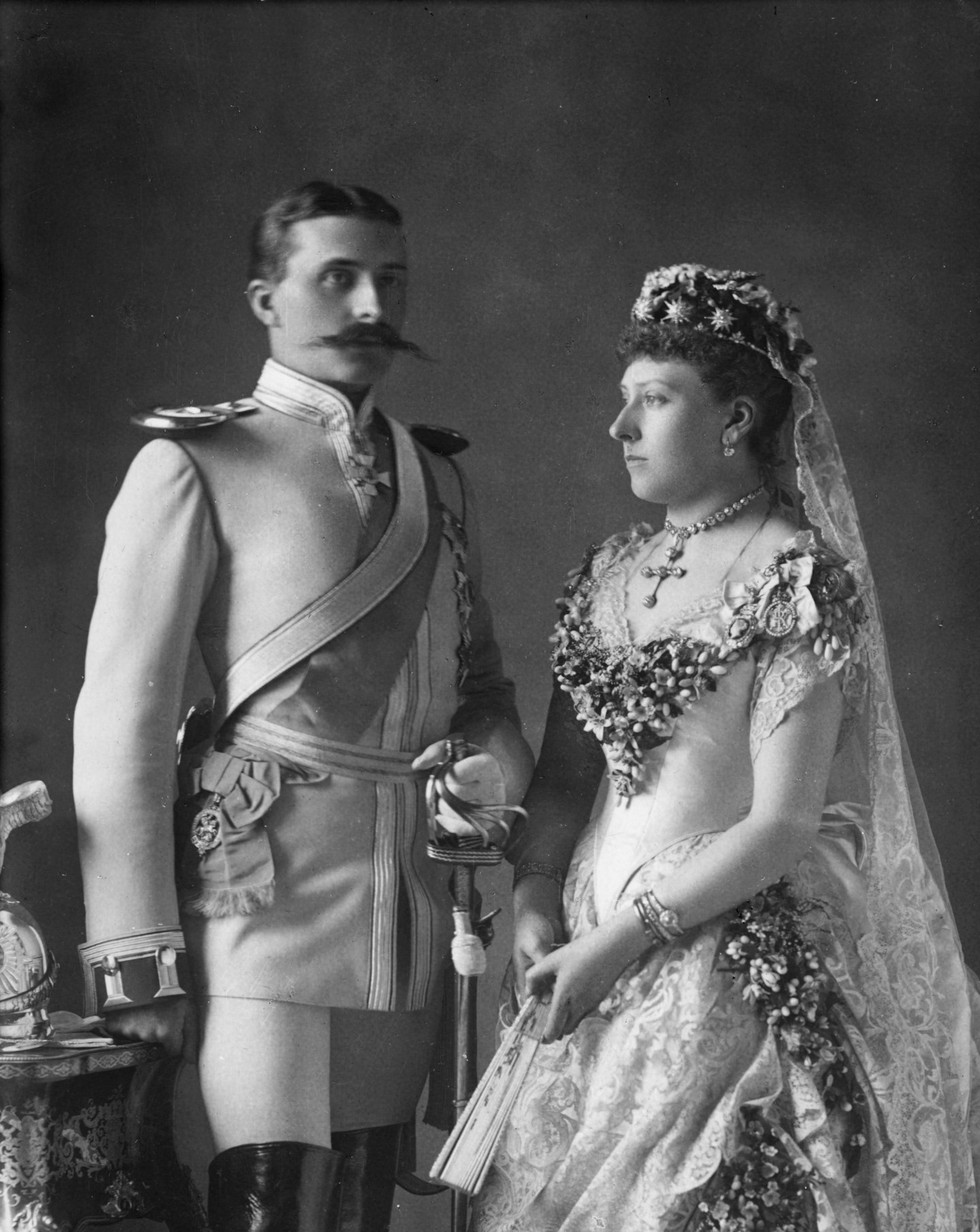 3 of 18
3 of 18Princess Beatrice, 1885
For her wedding to Prince Henry of Battenberg in 1885, Princess Beatrice, the youngest daughter of Queen Victoria, wore a fashionable white satin dress, trimmed with lace (which the Princess is said to have loved) and orange blossom. She was the only of Victoria's daughters to wear her mother's veil down the aisle, too.
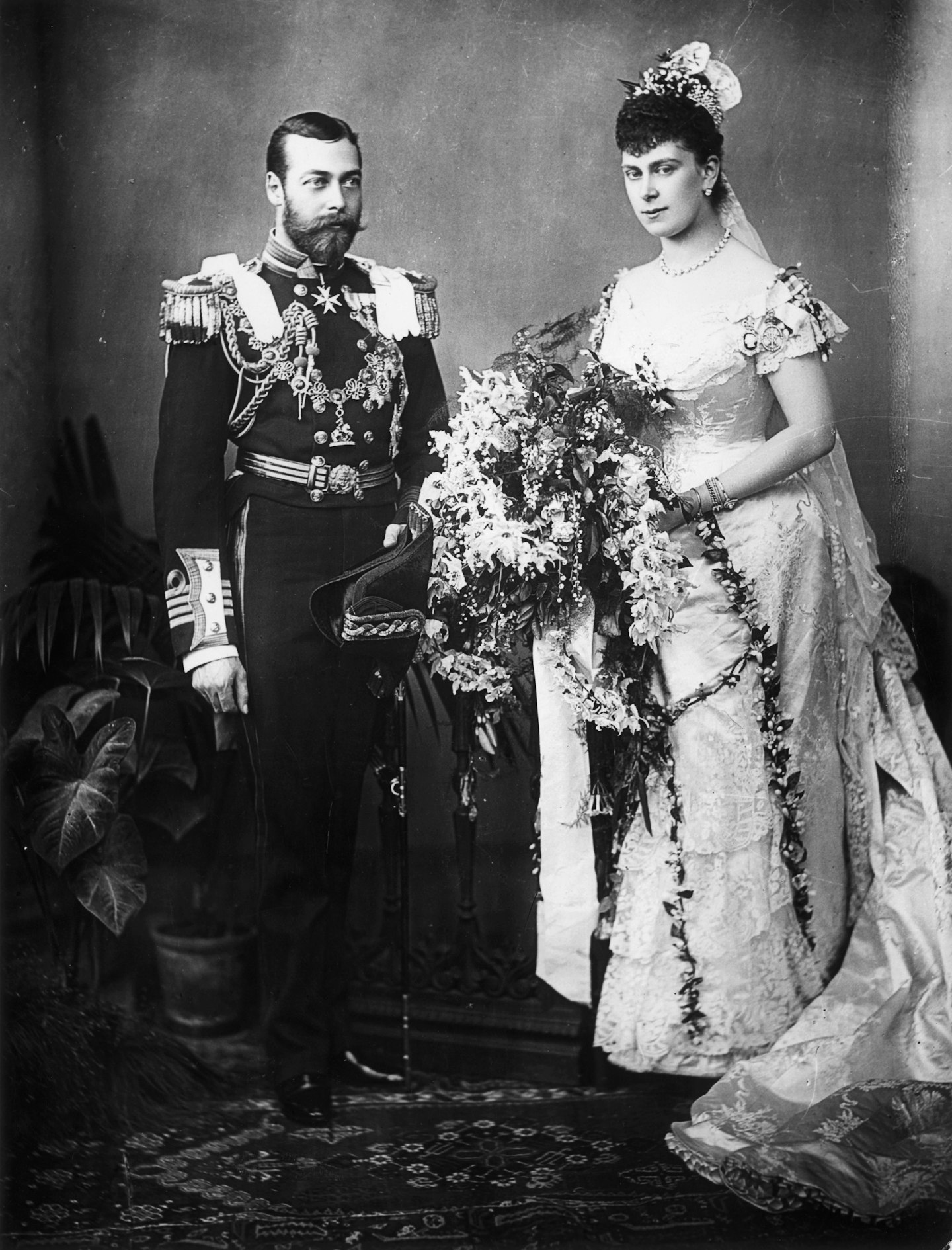 4 of 18
4 of 18Princess Mary of Teck, Queen consort, 1893
The future Queen Mary's wedding dress was designed by Arthur Silver of the Silver Studio, whose designs epitomised the Art Nouveau look. Her classic gown was embroidered with roses, shamrocks and thistles, with the choice of orange blossom for the trim echoed in small wreaths adorning her neckline and her hair. Her 'something old' was a small piece of Honiton lace from her mother's own wedding gown, with diamond jewellery from future mother-in-law Queen Victoria ticking off 'something borrowed.'
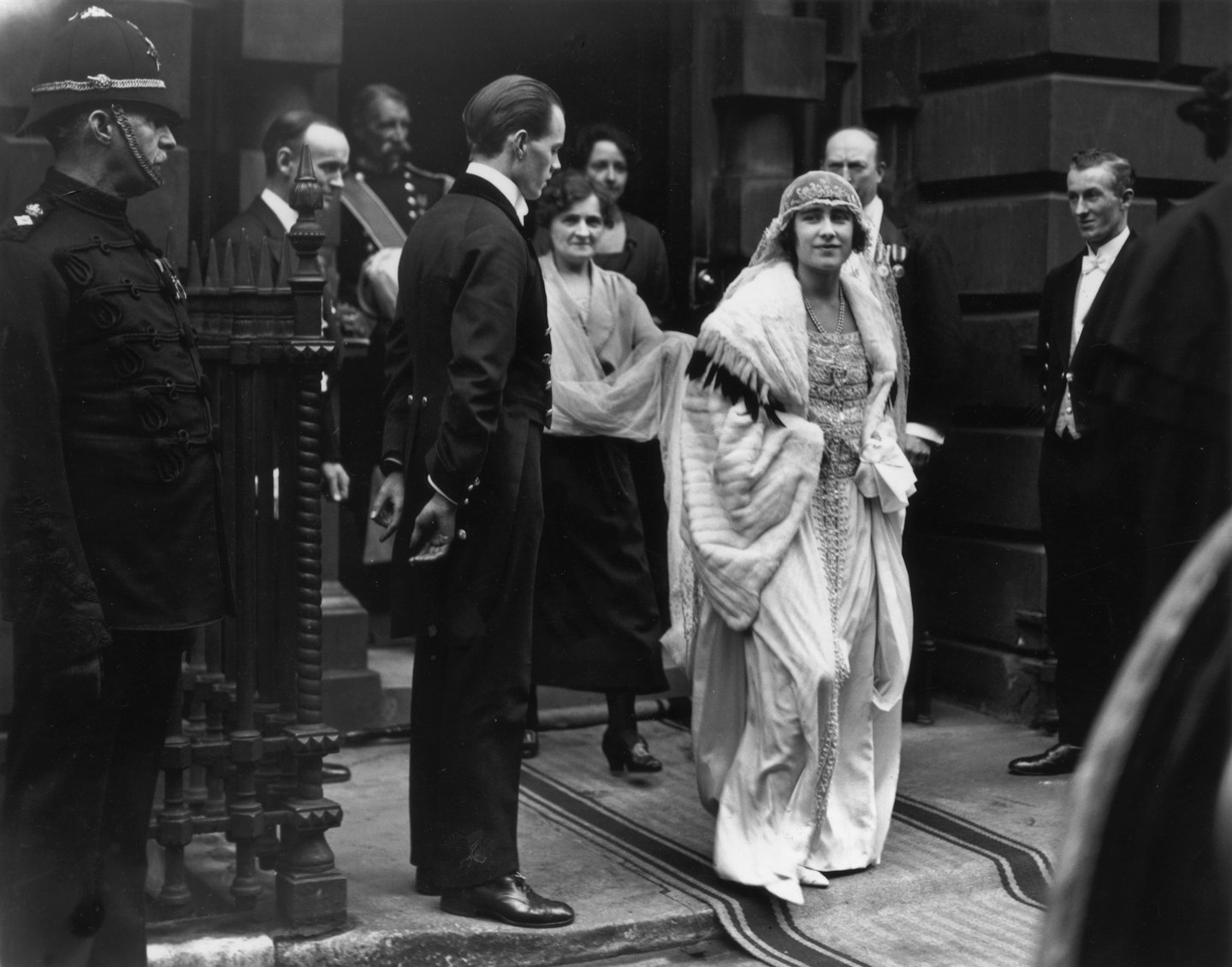 5 of 18
5 of 18Lady Elizabeth Bowes-Lyon, the Queen Mother, 1923
The future Queen Mother's wedding dress was quintessentially 1920s in style, with a simple drop waist. Designed by Madame Handley-Seymour, the dressmaker to Queen Mary, it was made of ivory silk crepe and embroidered with pearls. Her Flanders lace veil was held in place by a wreath of orange blossom and white roses, the latter a nod to the her future title of Duchess of York.
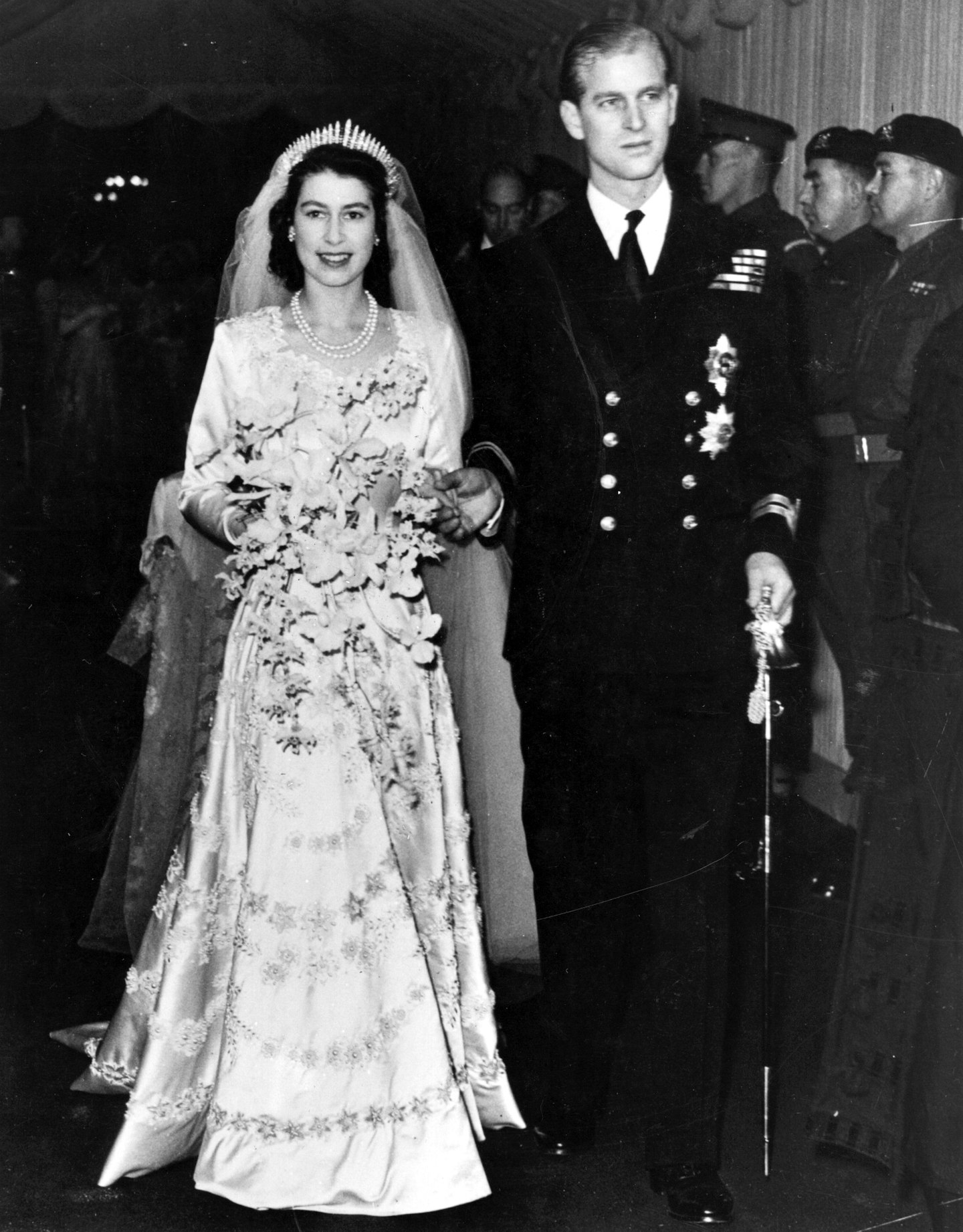 6 of 18
6 of 18Queen Elizabeth II, 1947
Court couturier Norman Hartnell described the wedding gown of the then-Princess Elizabeth as 'the most beautiful dress I had so far made.' Patterned with stars and floral embellishments, the dress – and its 13 foot train – was said to be inspired by Botticelli's Primavera, and to symbolise the nation's rebirth following the war. As clothing rationing was still in place (even for a Princess), Elizabeth had to purchase the fabric with ration coupons (though she was inundated with coupons from young women across the country, she had to return them to their owners).
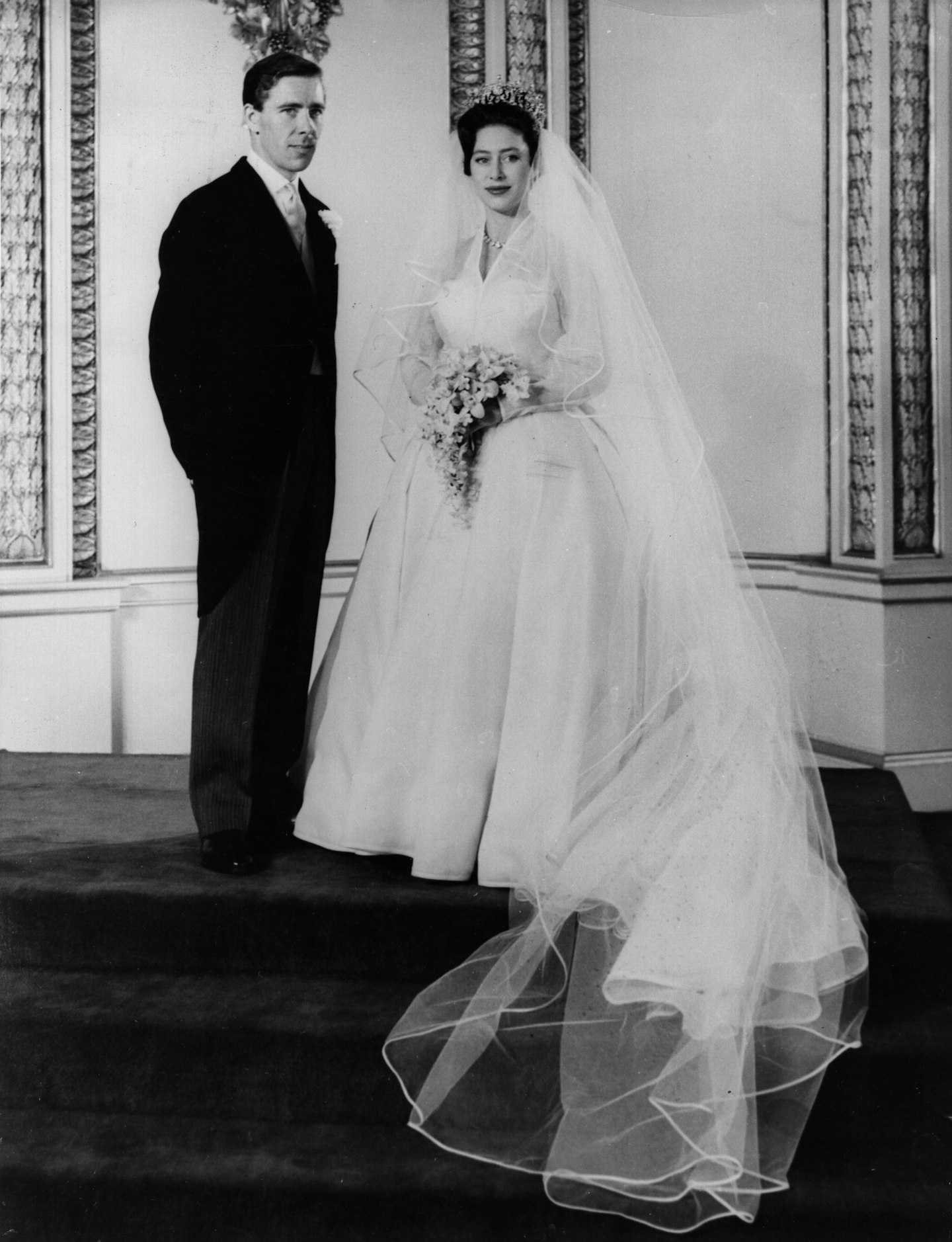 7 of 18
7 of 18Princess Margaret, 1960
When Princess Margaret married photographer Anthony Armstrong-Jones, she opted for a design by royal couturier Norman Hartnell. Comprising 30 metres of silk organza, the dress's simple shape and clean lines were designed to flatter the Princess's petite frame.
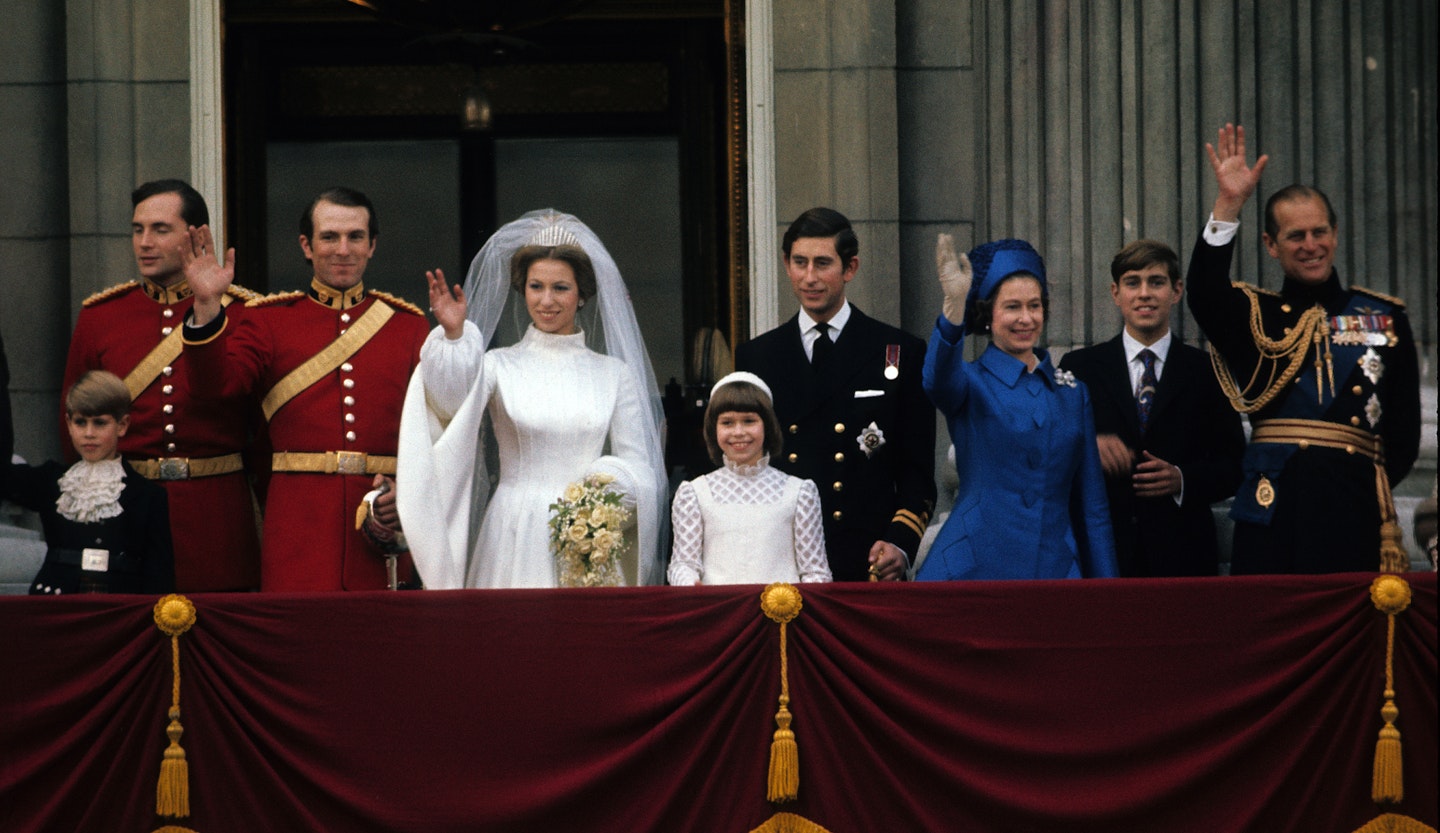 8 of 18
8 of 18Princess Anne, 1973
Ahead of her marriage to Captain Mark Phillips, Princess Anne seemed to take sartorial inspiration from times past, specifically the court of Queen Elizabeth I: her wedding gown, designed by Maureen Baker for Susan Small, featured a Tudor-style high neck and sweeping, almost medieval sleeves.
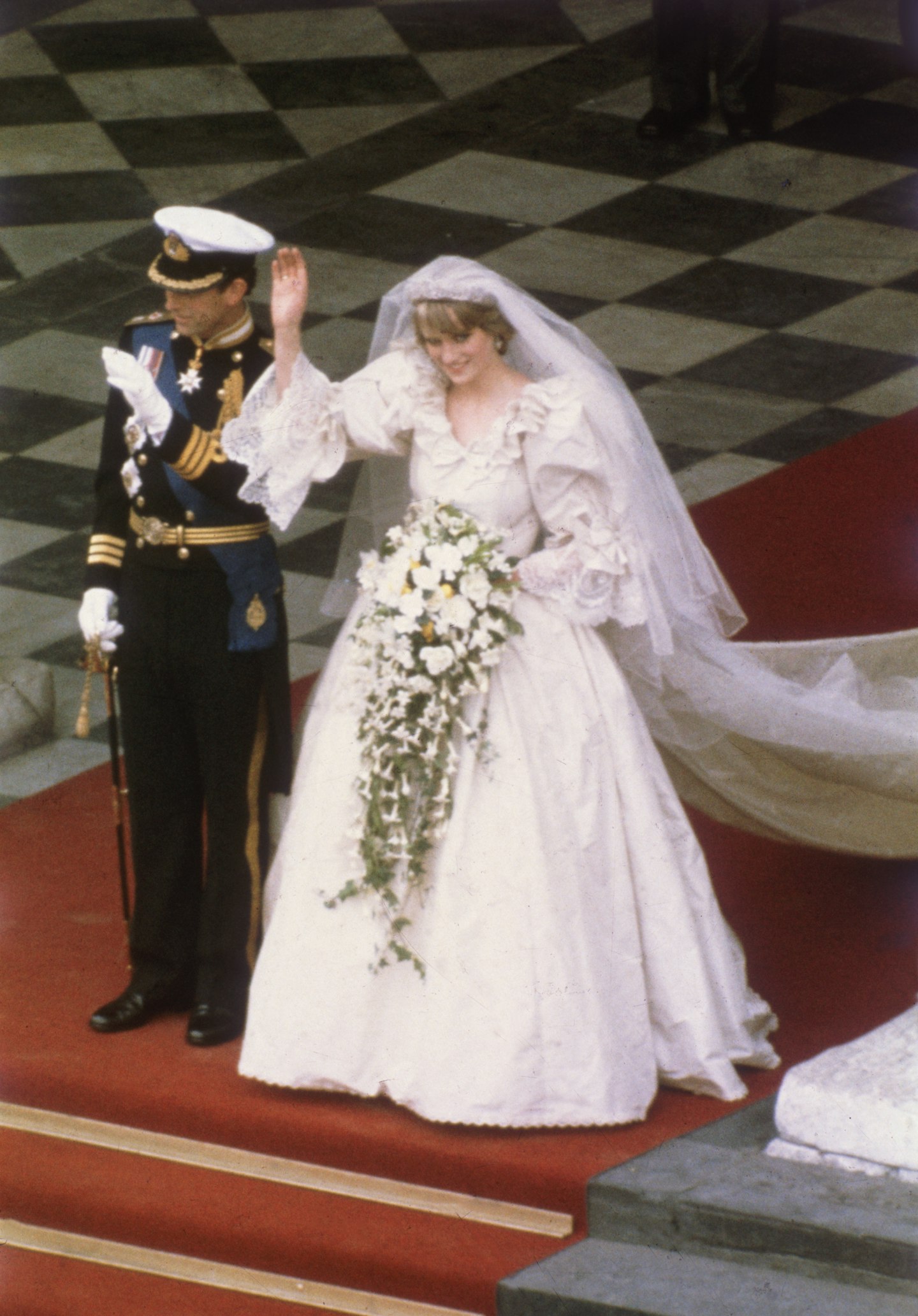 9 of 18
9 of 18Diana, Princess of Wales, 1981
Lady Diana Spencer's now-iconic 1981 wedding dress set bridal trends for years to come, with its puffed sleeves, 25-foot train and full skirt. Designed by David and Elizabeth Emanuel, the ivory silk taffeta gown was embellished with tiny sequins and pearls in a heart motif.
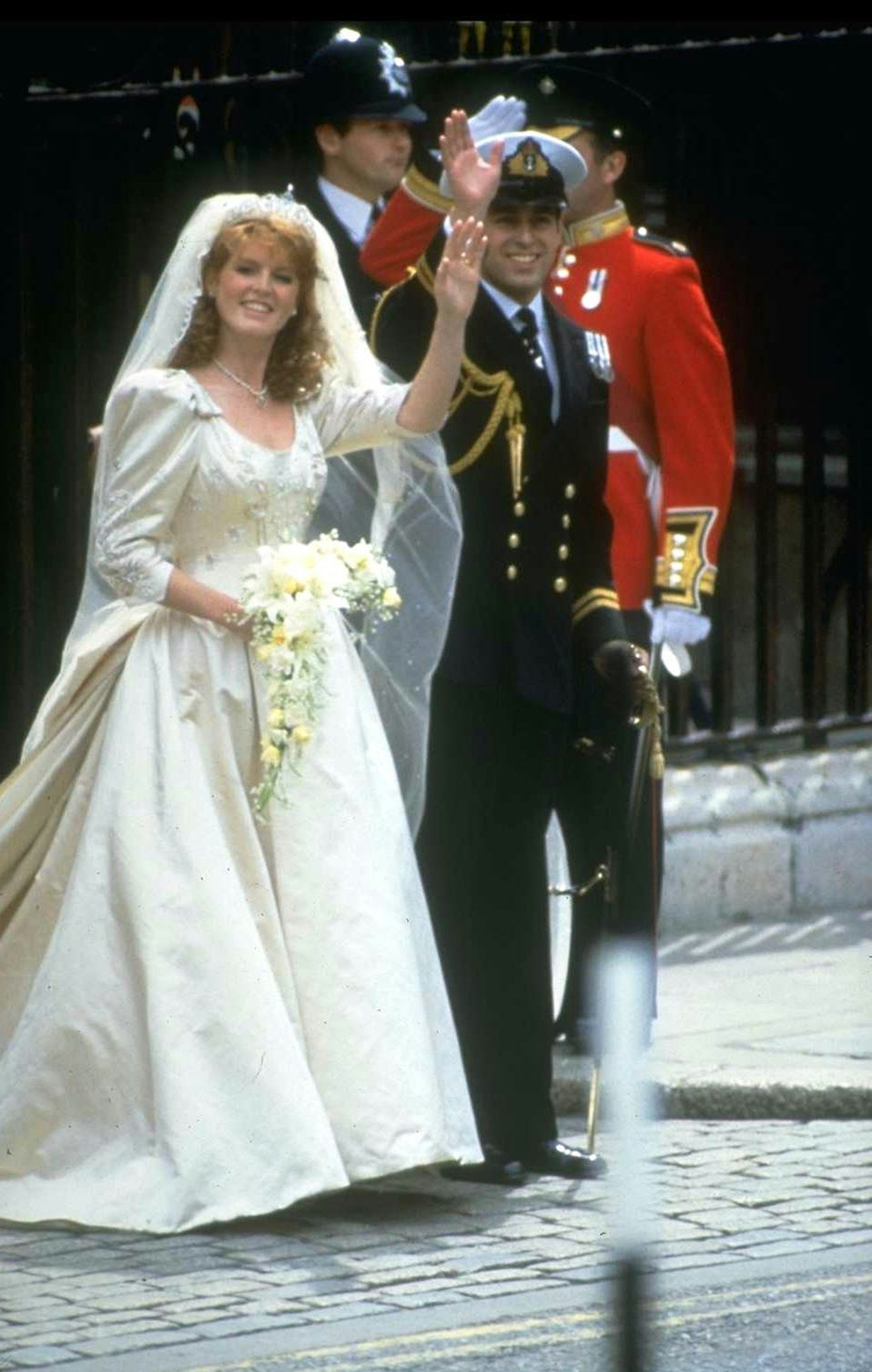 10 of 18
10 of 18Sarah, Duchess of York, 1986
Lindka Cierach designed this quintessentially '80s wedding dress for Sarah Ferguson's wedding to Prince Andrew. Made from ivory duchesse satin, it boasted a 17 foot long train embroidered with bees and thistles (a nod to her family's crest) and anchors and waves (symbolizing Prince Andrew's naval career). The York Diamond tiara which Fergie wore on the day was commissioned especially for her by her mother-in-law, the Queen.
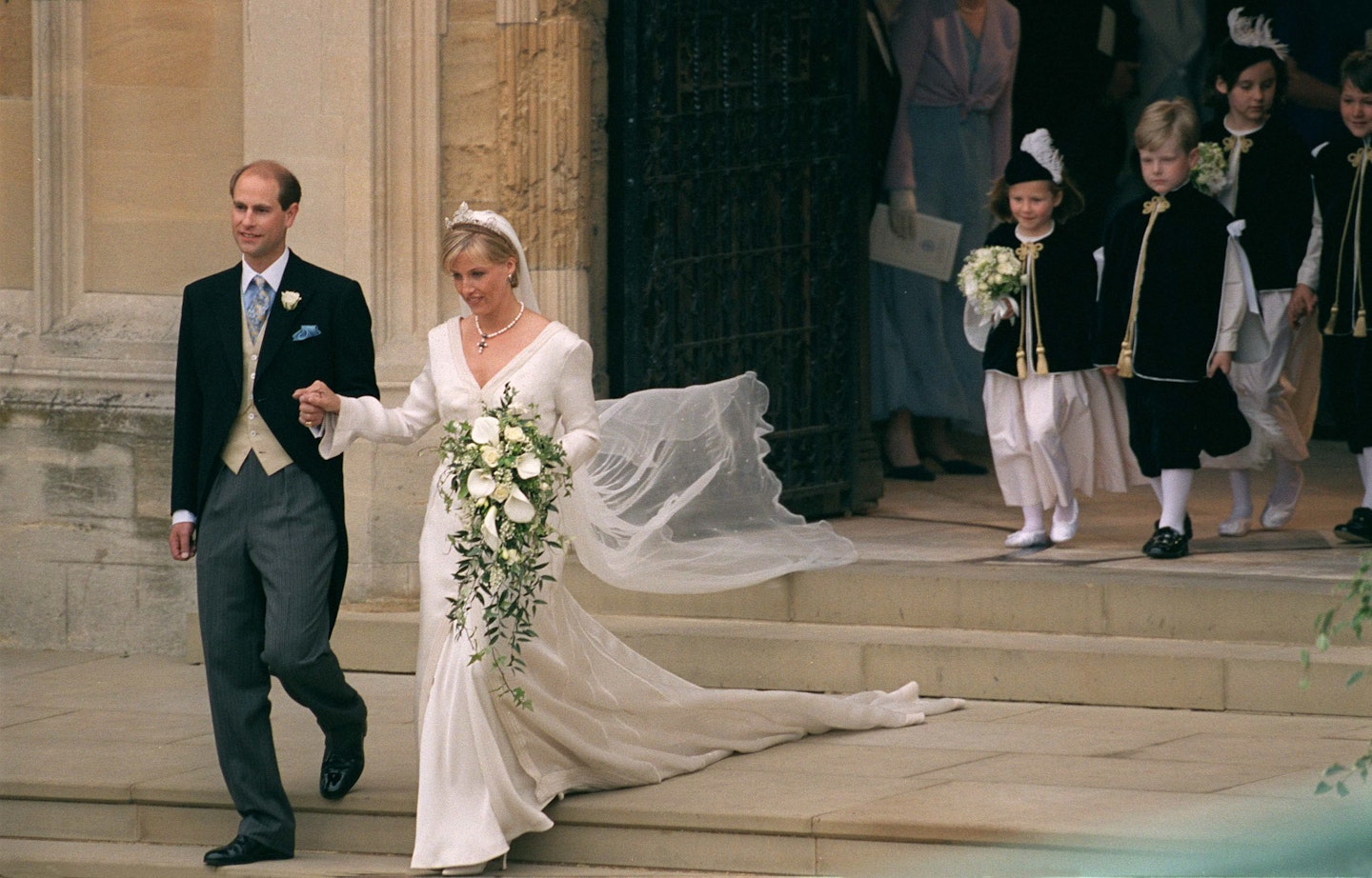 11 of 18
11 of 18Sophie, Countess of Wessex, 1999
Samantha Shaw was tasked with designing and making a dress for the wedding of Sophie Rhys-Jones (now the Countess of Wessex) to the Queen's youngest son, Prince Edward. The long-sleeved style was embellished with 325,000 cut glass and pearl beads.
 12 of 18
12 of 18Camilla, Duchess of Cornwall, 2005
Camilla's embroidered coat in pale blue and gold and matching chiffon gown were designed by Robinson Valentine for her wedding to the Prince of Wales at St George's Chapel, Windsor. Her statement headpiece – which featured Swarowski diamonds – was the handiwork of the royal family's favourite milliner, Philip Treacy.
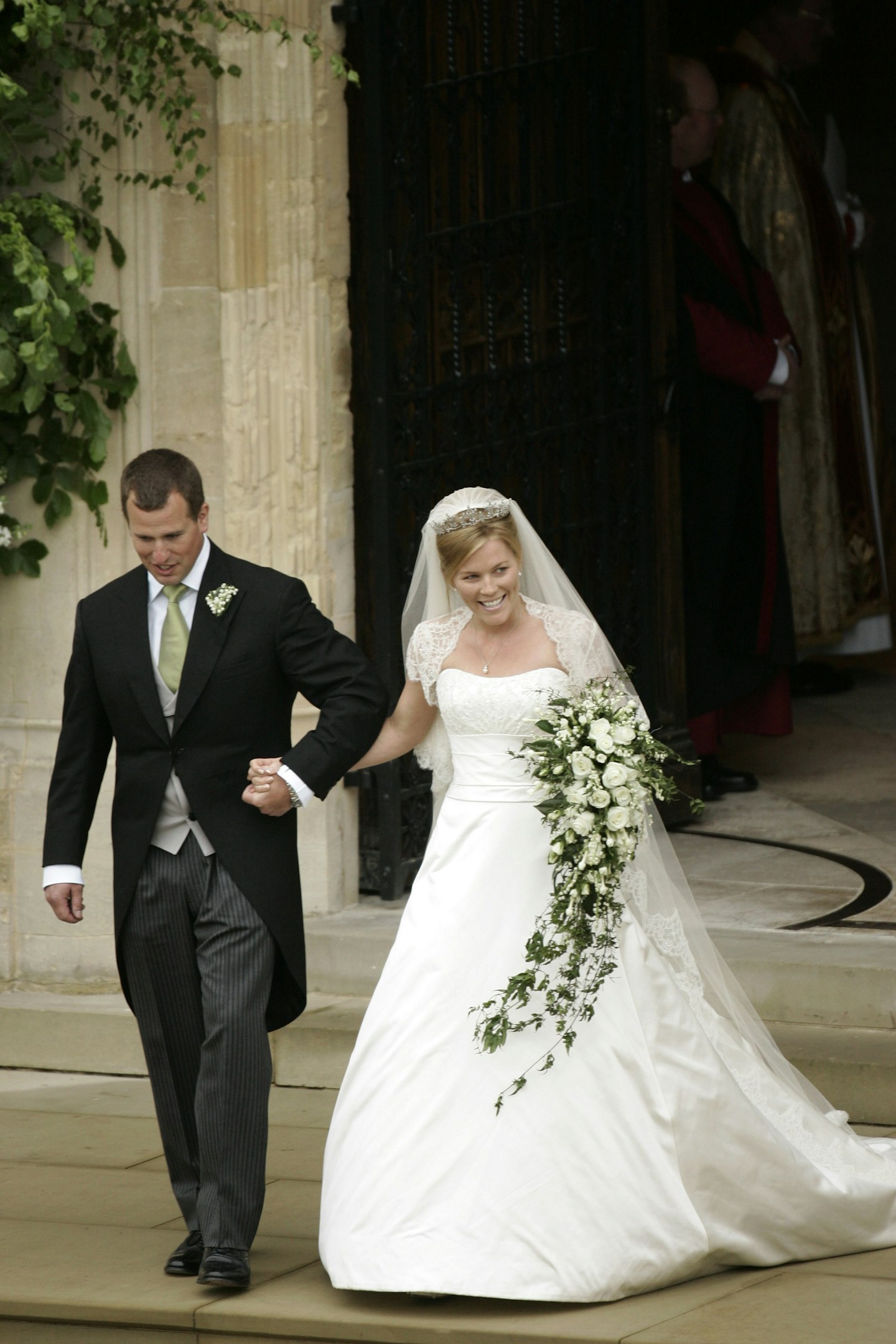 13 of 18
13 of 18Autumn Phillips, 2008
Canadian-born Autumn Kelly opted for a classic gown by British designer Sassi Holford, which featured a bodice fashioned from hand-beaded lace and a silk duchesse skirt, worn with a beaded shrug. The Festoon tiara which the bride wore on the day was borrowed from the collection of her mother-in-law, Princess Anne.
 14 of 18
14 of 18Zara Tindall, 2011
Zara Phillips wore a simple, classic gown with a full skirt and corseted bodice by Stewart Parvin, one of her grandmother the Queen's favourite couturiers, when she married rugby player Mike Tindall at Canongate Kirk in Edinburgh. The diamond tiara was the bride's 'something borrowed,' a loan from her mother Princess Anne.
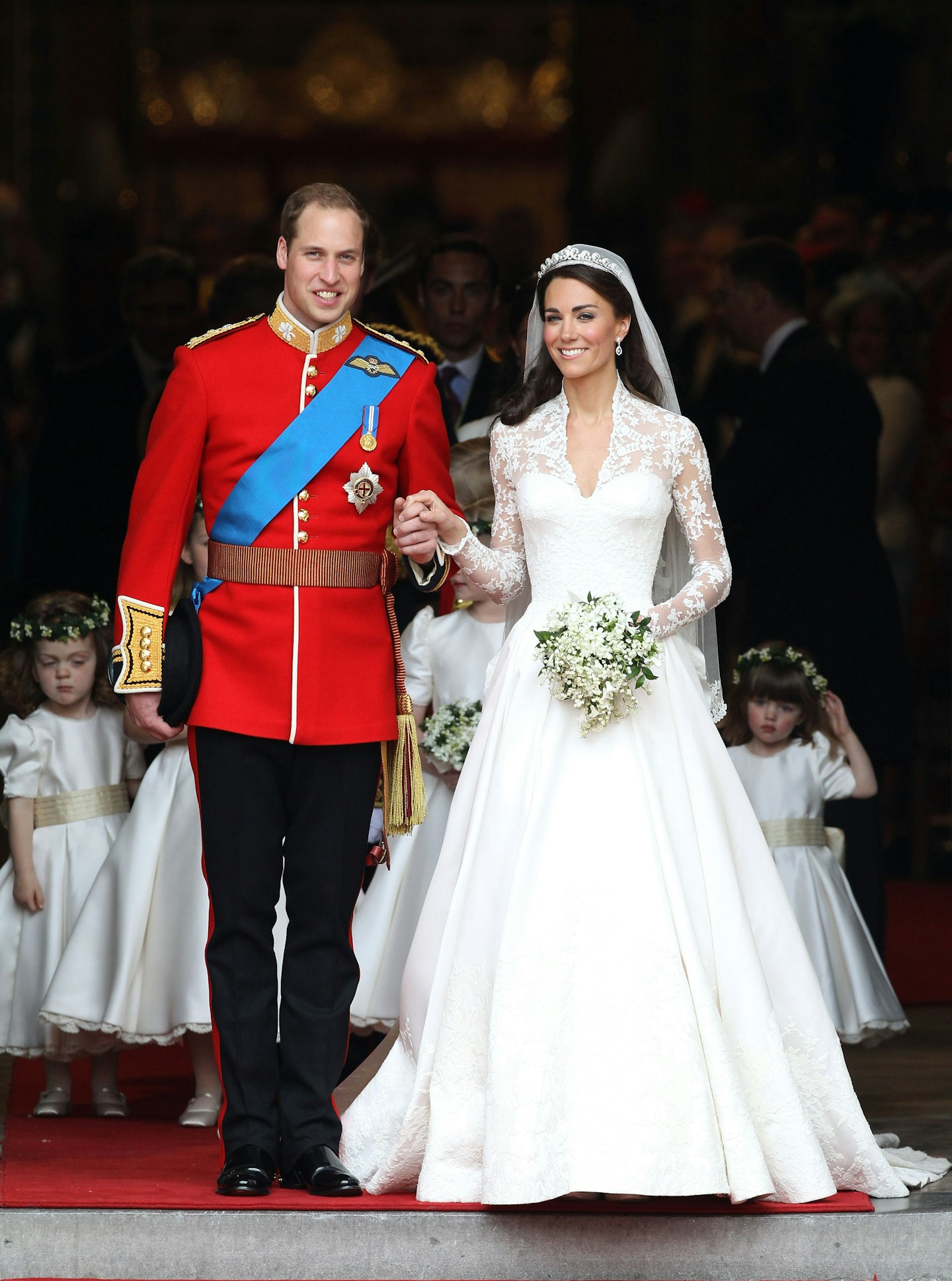 15 of 18
15 of 18Catherine, Duchess of Cambridge, 2011
Sarah Burton of Alexander McQueen landed the biggest fashion gig of the century so far when she was chosen by Kate Middleton to design a dress for her Westminster Abbey wedding to Prince William. The gown itself was made from ivory satin with long lace sleeves and floral motifs which were cut from machine-made lace then appliqued onto silk net by workers at the Royal School of Needlework.
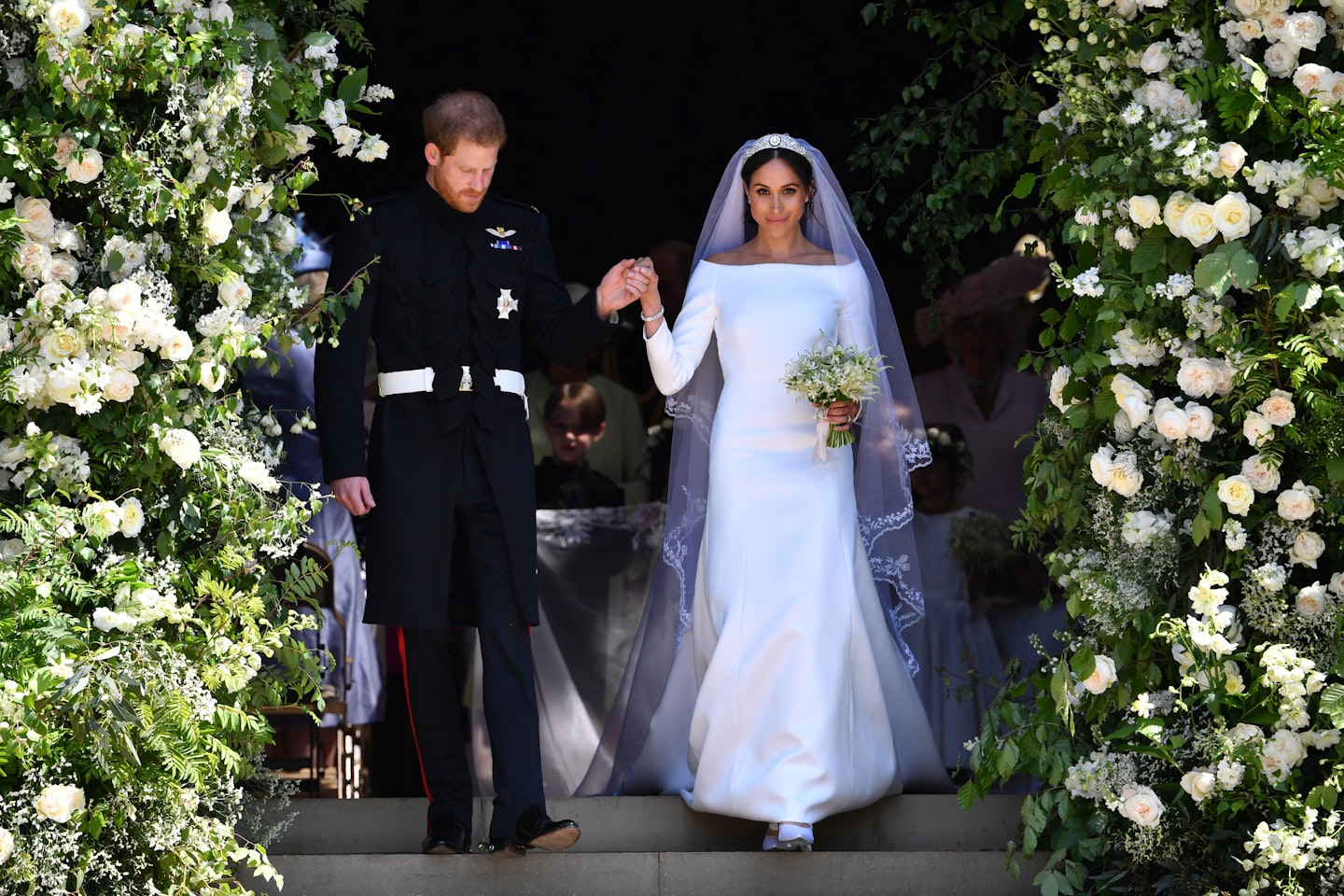 16 of 18
16 of 18Meghan, Duchess of Sussex, 2018
We all know that Givenchy's Clare Waight Keller designed Meghan Markle's wedding dress, but there's a fun fact about the detailing. The flowers embroidered into the veil represent the 53 nations of the Commonwealth, a nod to Prince Harry's role as Youth Ambassador.
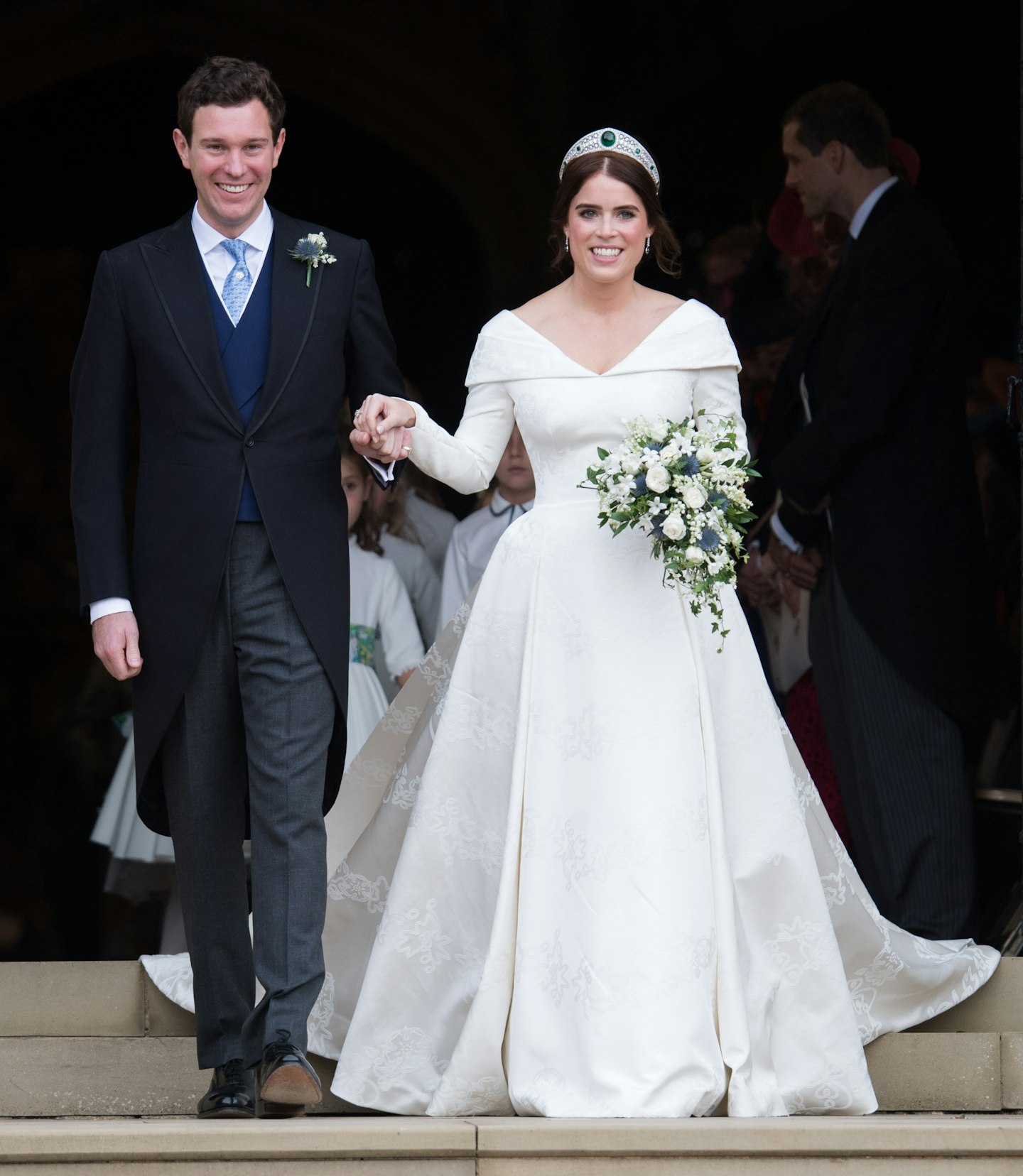 17 of 18
17 of 18Princess Eugenie of York, 2018
Princess Eugenie had a very particular request when it came to her wedding dress, which designer Peter Pilotto accommodated. He designed her dress with a low-back as to reveal the scars from her scoliosis surgery.
 18 of 18
18 of 18Lady Gabriella Windsor, 2019
Lady Gabriella Windsor walked down the aisle in a Luisa Beccaria gown, which as made "entirely in Valencienne écru lace layered with ribbons of flowers and buds" says the designer.
